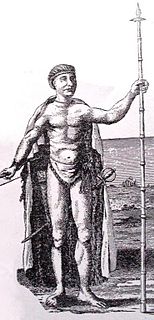 W
WThe Governorate of the Río de la Plata (1549−1776) was one of the governorates of the Spanish Empire. It was created in 1549 by Spain in the area around the Río de la Plata.
 W
WCangapol was a Tehuelche cacique born in the area of Huilin, on the Negro River in today's Argentina from 1735 to 1753. He was the chieftain of the nomadic Leuvuche people, who moved through a huge area from the Negro River to the Vulcan hills, today known as Tandilia hills, between the modern cities of Tandil and Mar del Plata. The Leuvuches were in fact called Serranos by the Spaniards. In 1751, Cangapol and his warriors expelled the Jesuits from Laguna de los Padres and destroyed the settlement built by them five years before. In 1753, he became an allied of the Spaniards against the Mapuches, who used to take profit of the Leuvuches' plunder raids north of the Salado river and then sought safe haven in Chile, leaving the Leuvuches to face the Spanish retaliation alone. He died the same year and was succeeded by his son Nicolás.
 W
WThe First Cevallos expedition was a series military actions between September 1762 and April 1763, by Spanish colonial forces led by Don Pedro Antonio de Cevallos, Governor of Buenos Aires, against Portuguese colonial forces in the Banda Oriental area on the aftermath of the failed Spanish and French Invasion of Portugal, as part of the Seven Years' War.
 W
WGuayrá was a historical region of the Spanish Empire, located in the Governorate of Paraguay, within the colonial Viceroyalty of Peru. The region is located in present-day Paraguay and Paraná.
 W
WThe Jesuit reductions were a type of settlement for indigenous people specifically in the Rio Grande do Sul area of Brazil, Paraguay and neighbouring Argentina in South America, established by the Jesuit Order early in the 17th century and wound up in the 18th century with the banning of the Jesuit order in several European countries. Subsequently it has been called an experiment in "socialist theocracy" or a rare example of "benign colonialism".
 W
WNombre de Jesús was a Spanish town in Patagonia, settled in 1584 by Pedro Sarmiento de Gamboa in the Magellan Strait. Nombre de Jesús also refers to the archaeological site located in Santa Cruz Province, Argentina, where the remains of this settlement were found. This was the first European settlement in the Magellan Strait.
 W
WReducción de Santa María la Mayor, located in the Santa María Department of the Misiones Province, Argentina, at approximate coordinates 27°33′S 55°20′W, was one of the missions or reductions founded in the 17th century by the Jesuits in the Americas during the Spanish colonial period. In 1984 it was one of four reduction sites in Argentina designated as World Heritage Sites by UNESCO.
 W
WSão Miguel das Missões is a municipality in Rio Grande do Sul state, southern Brazil. Important 17th century Spanish Jesuit mission ruins are located in the municipality. San Miguel Mission is within Santo Ângelo Microregion, and the Riograndense Northwest Mesoregion. The city covers 1,246 square kilometres (481 sq mi) and had a population of 7,682 resident.